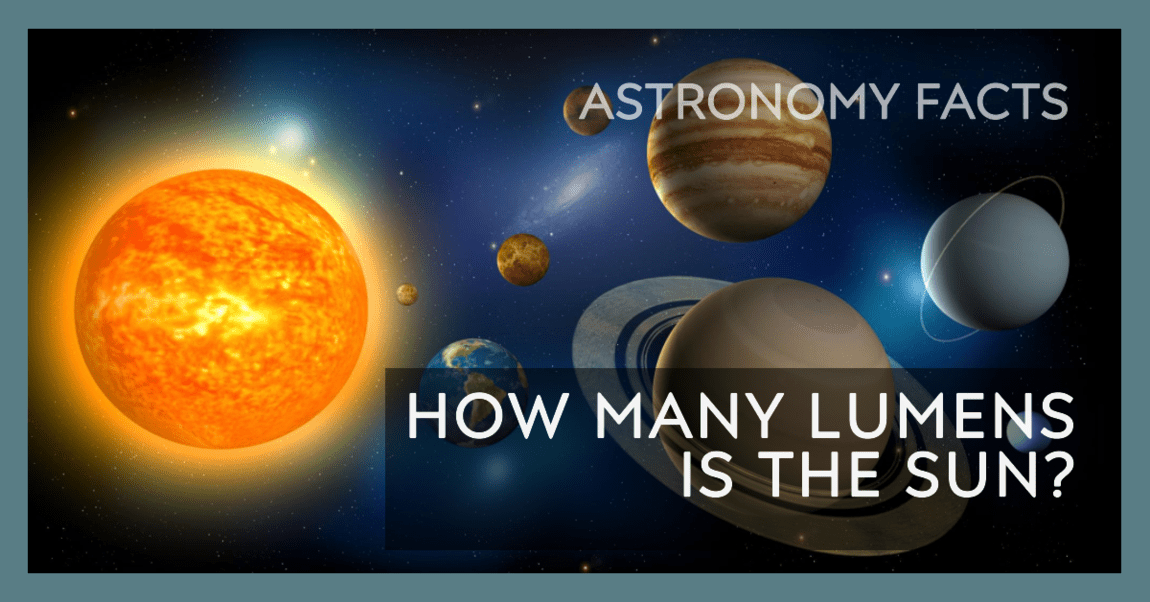For thousands of years, people have been charmed by the marvelous cosmic spectacle we call sunlight. It’s more than just a way to keep warm it holds an irresistible allure. But have you ever wondered: How Many Lumens is the Sun?

At first glance, the question may seem straightforward, but closer examination reveals a world of complexity hidden within the sunshine. Join this TechyNerd guide on a journey that promises to show you our celestial source of light’s utter magnificence & intricate beauty and answer the question “How Many Lumens is the Sun” in the best way possible.
What is Lumens?
Lumens measure the amount of visible light emitted by a source in a given period. Unlike radiant flux, which covers all electromagnetic waves emitted, lumens consider how the human eye perceives different wavelengths.
Simply put, one lumen is the visible light emitted within a specific angle by a source with a luminous intensity of one candela. It’s like gauging the brightness of light within a defined space or coming from a particular source.
What is the difference between lumens and lux?
A bulb or Source’s brightness is indicated by the total amount of light it emits in lumens. Lux indicates a surface’s apparent brightness by measuring the amount of light that reaches it. While lux evaluates the amount of light hitting a surface, lumens concentrate on one light source. To ensure safety and comfort, light levels direct the proper illumination for tasks. Understanding and maximizing lighting efficiency for various settings requires both measurements.
Also Read: 13 Proven Strategies: How to Block Mind Reading Technology?
How Many Lumens is the Sun?
The Sun, glowing with Black Body Temperature at 5778 K, emits 93 lumens per watt and grants Earth about 127,000 lumens per square meter. This substantial light makes the Sun appear incredibly bright from our viewpoint. Caution is crucial: direct Sun viewing can harm your eyes. Remember to safeguard yourself by wearing sunglasses and using sunscreen to protect your eyes and skin from its intense rays.
What is a Black Body Temperature?
A black body absorbs all types of radiation, emitting what’s called black-body radiation when in thermal balance. This emitted radiation follows Planck’s law, meaning it’s solely dictated by temperature, not shape or composition.
The “black body temperature” refers to the temperature a body’s surface (like Earth) would have without its atmosphere. Calculated by the Stefan–Boltzmann equation, Earth’s black body temperature is -23°C, whereas its actual surface is around 15°C.

In astronomy, stars and planet’s radiation is sometimes described using an “effective temperature,” akin to the temperature of a black body emitting the same amount of energy.
Also Read: 11 Best Upwind vs. Downwind Strategies in Technological Innovation

How does the Sun produce light?
The Sun generates light via nuclear fusion in its core, merging hydrogen atoms to form helium due to intense heat and pressure. During fusion, a vast amount of energy emitted as heat & light, travels from the core to the surface over roughly 40,000 years. This journey involves an intricate absorption and re-emission by atoms, often described as a “drunken walk.”
When this energy finally reaches the Sun’s surface, it’s emitted as light and various electromagnetic forms of radiation. It takes around eight minutes for this light to travel the vast 93 million miles to Earth.
So, to answer the question, “How Many Lumens is the Sun?”, The specific number of lumens isn’t typically measured directly from the Sun’s emission. Instead, the light we see results from a complex process involving nuclear fusion, energy transfer, and the emission of various forms of radiation.
How does the Sun’s energy reach Earth?
The Sun’s energy, traveling as electromagnetic radiation, reaches Earth in about 8 ⅓ minutes, spanning a distance of 149 million km (93 million miles). This energy primarily includes visible light and invisible infrared, with a smaller fraction being ultraviolet radiation.
Additional solar radiation, comprising plasma, particles, gamma rays, and x-rays, reaches Earth via the solar wind, though in smaller quantities and longer travel times.
Once this energy reaches Earth, it heats the planet and drives crucial life processes like photosynthesis and animal vision. However, measuring “How Many Lumens is the Sun” directly from its emitted radiation isn’t common due to the intricate mix of energy types it emits. The Sun emits various forms of energy, including visible light, making it challenging to precisely quantify its lumens output.
Also Read: 15 Big Reasons: What Might Cause a Shotgun to Explode?
How do Scientists measure the brightness of the sun?

Scientists assess the Sun’s brightness using a unit called solar luminosity, comparing it to other stars and celestial objects. One solar luminosity equals about 3.828 × 10^26 watts. The Sun’s brightness slightly fluctuates due to its eleven-year sunspot cycle, varying by approximately ±0.1%.
Solar luminosity connects to solar irradiance, influencing Earth’s climate patterns through the solar constant. To calculate solar luminosity, you multiply the solar constant by the area of the space around Earth. For measuring sunshine, tools like Campbell-Stokes recorders and modern sensors are used, along with devices like pyranometers to measure global radiation.
However, this information doesn’t directly determine “How Many Lumens is the Sun,” focusing more on solar luminosity, irradiance, and methods for measuring sunlight.
Why does the Sun’s brightness fluctuate?
The Sun’s brightness alters due to magnetic fields on its surface and internal plasma movements. Magnetic fields create dark sunspots, affecting brightness changes over more extended periods, while plasma movements in the granulation pattern cause rapid brightness shifts within shorter durations.
Regarding “How Many Lumens is the Sun,” this insight doesn’t directly measure the Sun’s lumens output but provides understanding on the Sun’s brightness variations over different time scales.
How does the Sun’s magnetic field affect Earth?
The Sun’s magnetic field affects Earth profoundly, shaping solar weather with stunning auroras and triggering space phenomena like solar flares and Coronal Mass Ejections (CMEs). These catastrophes have an influence on our day-to-day lives by busting electricity systems, navigation, & satellites. Similarly, solar magnetic disturbances release energy, which alters our atmosphere and may affect communication and satellite trajectories.
The Earth’s defensive magnetic wall protects humans from solar winds & cosmic radiation, allowing life to live. While important for Earth’s dynamics, this data doesn’t directly quantify” How Many Lumens is the Sun,” but rather focuses on its effect on our globe.
Also Read: The Truth Behind Why Does 5G Sucks?: Myths, Facts & Reality Unveiled
Why do we need to study solar flares and CMEs?
Understanding solar flares and Coronal Mass Ejections (CMEs) is crucial for various reasons:
Space Weather Prediction
Predicting space weather events caused by these marvels aids in the protection of the Earth’s magnetosphere.
Technological Impact
Understanding solar flares and CMEs helps to prepare and secure power grids, communication networks, and navigation systems against interruptions.
Astronaut Safety
Understanding these phenomena helps astronauts avoid dangerous high- energy particles during space operations.
Scientific Understanding
They shed light on the Sun’s magnetic field, plasma physics, and astronomical events.
Climate Studies
The impact of solar events on Earth’s climate emphasizes their applicability in climate modeling.
Final Thought
We’ve answered the immersing mystification of “How Many Lumens is the Sun” as we’ve completed our TechyNerd trip into the radiant cosmos. Let’s move forward with a fresh appreciation for the brilliance that sustains life on our light blue fleck as we phenomenon at the luminous grasp of the sun. May your curiosity continue to shine as brightly as the sun itself as you embrace the light.
FAQ’s
How bright is 10,000 lumens?
Similar to the brightness of 10,000 candles, 10,000 lumens is a significant amount of light. It is frequently used in projectors, high-output lighting, & occasionally briefly in flashlights. It effectively illuminates large areas outside and provides floodlighting for security purposes. This level of brightness, however, can become too intense for practical use when near a surface. For instance, while it offers excellent visibility for nighttime biking, using it close to cars may cause excessive glare on the roads.
Is there a light brighter than the Sun?
Yes, there are light sources in the universe that are brighter than the Sun. There exist cosmic entities brighter than the Sun. Ultra-luminous X-ray sources, emitting about 10 million times the Sun’s energy, surpass the Eddington limit, defying brightness expectations based on mass. Stars like Rigel in Orion, 40,000 times brighter than the Sun, and the immensely radiant Pistol Star, 1.6 million times brighter, also surpass our Sun’s luminosity.
How many lumens can damage your eyes?
The human eye can withstand a few hundred lumens without severe harm, but exposure to over 10,000 lumens may lead to lasting damage. For self-defense in darkness, 100-200 lumens can disorient an attacker effectively. In dim settings, 80 lumens can cause temporary blindness, while 200 lumens in daylight may induce temporary vision impairment. It’s safer to avoid direct exposure to any intense light source unless necessary. Wearing protective eyewear and opting for “warm” LED lights can help prevent potential eye damage from bright lights.
How many lumens is indirect sunlight?
Indirect sunlight typically ranges between 5,000 to 10,000 lumens, but this estimate varies based on room size and surface reflectivity. A rough guideline suggests needing 50-100 lumens per square foot in a space. Light meter measurements indicate indirect sunlight with lux values spanning from 1076.39 to 5381.96. However, converting lux to lumens relies on the illuminated area and its specific characteristics.

